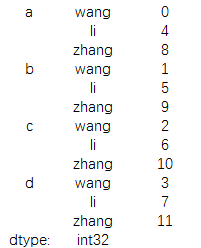
Earlier we used pandas to perform some basic operations. Next, we will learn more about data operations.
Data cleaning has always been an extremely important part of data analysis.
Data merging
In pandas, data can be merged through merge.
import numpy as np
import pandas as pd
data1 = pd.DataFrame({'level':['a','b','c','d'],
'numeber':[1,3,5,7]})
data2=pd.DataFrame({'level':['a','b','c','e'],
'numeber':[2,3,6,10]})
print(data1)The result is:

##
print(data2)
The result is:

print(pd.merge(data1,data2))
The result is:

You can see that the fields used for the same label in data1 and data2 are displayed, while other fields are discarded. This is equivalent to the inner join connection operation in SQL.
data3 = pd.DataFrame({'level1':['a','b','c','d'],
'numeber1':[1,3,5,7]})
data4=pd.DataFrame({'level2':['a','b','c','e'],
'numeber2':[2,3,6,10]})
print(pd.merge(data3,data4,left_on='level1',right_on='level2'))The result is:

If the column in the two data frames When the names are different, we can connect the data together by specifying the two parameters letf_on and right_on
print(pd.merge(data3,data4,left_on='level1',right_on='level2',how='left'))
The result is:
 Other detailed parameter description
Other detailed parameter description

Sometimes We will encounter overlapping data that needs to be merged. In this case, we can use the comebine_first function.
data3 = pd.DataFrame({'level':['a','b','c','d'],
'numeber1':[1,3,5,np.nan]})
data4=pd.DataFrame({'level':['a','b','c','e'],
'numeber2':[2,np.nan,6,10]})
print(data3.combine_first(data4))The result is:

You can see the results under the same tag The content of data3 is displayed first. If a certain data in a data frame is missing, the elements in another data frame will be filled in.
The usage here is similar to np.where (isnull(a),b,a)
We mentioned this content in the previous pandas article. Data reshaping mainly uses the reshape function, and rotation mainly uses the unstack and stack functions.
data=pd.DataFrame(np.arange(12).reshape(3,4),
columns=['a','b','c','d'],
index=['wang','li','zhang'])
print(data)The result is:
 ##
##
print(data.unstack())
The result is:
 Data conversion
Data conversion
Delete duplicate row data
data=pd.DataFrame({'a':[1,3,3,4],
'b':[1,3,3,5]})
print(data)
print(data.duplicated())
 It can be seen that the third row repeats the data of the second row, so the displayed result is True
It can be seen that the third row repeats the data of the second row, so the displayed result is True
另外用drop_duplicates方法可以去除重复行
print(data.drop_duplicates())
结果为:
替换值
除了使用我们上一篇文章中提到的fillna的方法外,还可以用replace方法,而且更简单快捷
data=pd.DataFrame({'a':[1,3,3,4],
'b':[1,3,3,5]})
print(data.replace(1,2))结果为:

多个数据一起换
print(data.replace([1,4],np.nan))

数据分段
data=[11,15,18,20,25,26,27,24] bins=[15,20,25] print(data) print(pd.cut(data,bins))
结果为:
[11, 15, 18, 20, 25, 26, 27, 24][NaN, NaN, (15, 20], (15, 20], (20, 25], NaN, NaN, (20, 25]]
Categories (2, object): [(15, 20] < (20, 25]]
可以看出分段后的结果,不在分段内的数据显示为na值,其他则显示数据所在的分段。
print(pd.cut(data,bins).labels)
结果为:
[-1 -1 0 0 1 -1 -1 1]
显示所在分段排序标签
print(pd.cut(data,bins).levels)
结果为:
Index([‘(15, 20]', ‘(20, 25]'], dtype='object')
显示所以分段标签
print(value_counts(pd.cut(data,bins)))
结果为:

显示每个分段值得个数
此外还有一个qcut的函数可以对数据进行4分位切割,用法和cut类似。
排列和采样
我们知道排序的方法有好几个,比如sort,order,rank等函数都能对数据进行排序
现在要说的这个是对数据进行随机排序(permutation)
data=np.random.permutation(5) print(data)
结果为:
[1 0 4 2 3]
这里的peemutation函数对0-4的数据进行随机排序的结果。
也可以对数据进行采样
df=pd.DataFrame(np.arange(12).reshape(4,3)) samp=np.random.permutation(3) print(df)
结果为:

print(samp)
结果为:
[1 0 2]
print(df.take(samp))
结果为:

这里使用take的结果是,按照samp的顺序从df中提取样本。
更多python 数据清洗之数据合并、转换、过滤、排序相关文章请关注PHP中文网!




